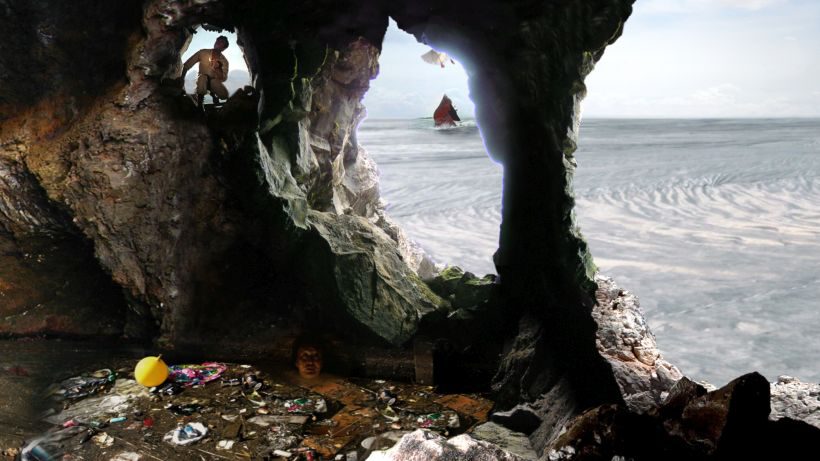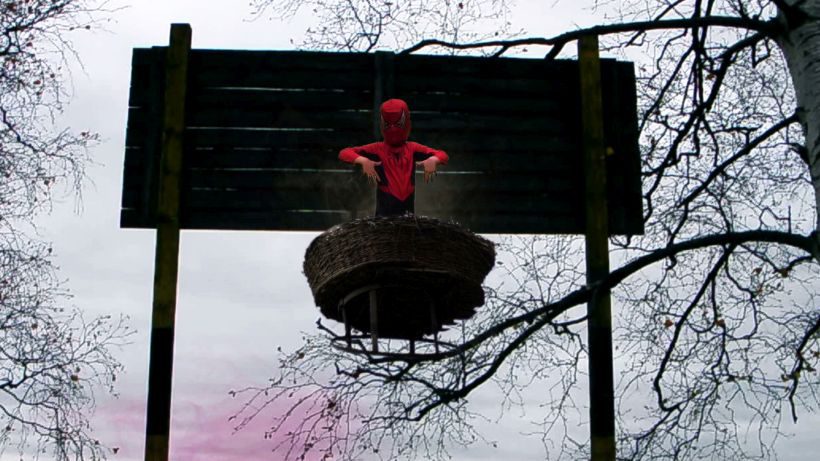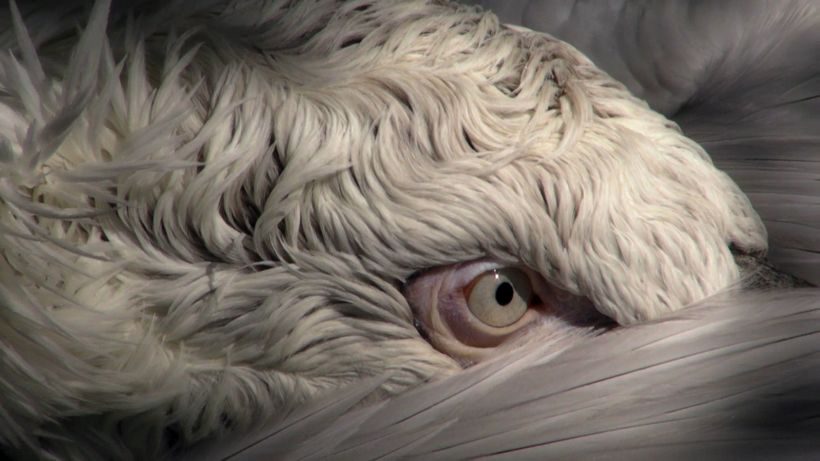Allowing the gaze to roam and discovering new things

WESTCOAST © Ulu Braun
Ulu Braun is based in Berlin and his work is represented at both film festivals and in the art world. He perceives this double-track approach as a privilege, allowing him the freedom to experiment and broaden his own horizons by regularly traversing boundaries. Braun is the kind of artist who looks for and chooses his medium for each project anew. In recent years, he has increasingly settled on the moving image, leading Braun to describe himself in conversation as a “hybrid-auteur-filmmaker”. It is no accident that authorship takes centre stage in this respect. Braun places great importance on being able to realise his artistic ideas without compromise, and to date, chooses to work beyond classic film funding structures.
Initially studying Painting and then Experimental Film at the University of Applied Arts Vienna, Ulu Braun has adopted a number of diverse techniques since the beginning of his artistic career and interlocks them in his work. The first of which were graffiti and painting, moving pictures came along later. It is hardly surprising then, that his early video work, such as SÜDWEST (2006), WESTCOAST (2009) and ATLANTIC GARDEN (2010) recalls the detailed panoramas of Renaissance painter Hieronymus Bosch.
Composed as panning shots, at first glance the painted friezes appear to be chaotic and overfilled. Artificial lifeworlds collaged from different sources and populated with more or less everyday phenomena. Unperturbed scientists and rubbish collectors act alongside frenzied inflatable boats, baby hippos and a fisherman who busily slaughters the freshly-caught tuna heaped around him. All manner of things happen concurrently in alternating parts of the picture, compelling the observer to constantly switch their gaze back and forth for fear of missing something. Those looking for a leitmotif or clear causalities would search in vain, as the pieces are more concerned with the absurdity of the concurrent and the art of practicing a particular way of looking at things – that of being consciously aware of how one’s own perspective has a determining influence on the story.
https://vimeo.com/99187212 (WESTCOAST)
https://vimeo.com/87422355 (ATLANTIC GARDEN)
Producing these complex video-panoramas is highly time-consuming, owing in part to the fact that Ulu Braun undertakes most of the complicated editing and animation processes himself. He considers the mastering of individual steps in film production to be an essential personal need.
“I am a decidedly intuitive filmmaker and do not like to follow a plan or resort to divisional labour structures. Both of which however – the division of labour and long-term planning – characterize the working process in the traditional film industry. As a result, I usually choose to work beyond these structures and have made it a personal principal to master the important working steps and techniques myself, in order to spontaneously apply them without suffering qualitative losses.”
In 2000, his fascination for craftsmanship, combined with a distinctly critical approach towards the media led Braun to commence Animation studies at the Academy for Film and Television in Potsdam. There he planned on taking the opportunity to explore the enormous apparatus of film and media production from within, with the intention of subverting it from an artistic perspective.
It proved however that the media apparatus was equally equipped with formidable resolve. Braun experienced this significantly during the production of his animated short film DIE FLUTUNG VON VIKTORIA (2004). In the over twenty-minute long puppet/animation/miniature/ fiction film, numerous tourists set off on a bus journey to the Victoria Plains a few days before the area is scheduled to be flooded. An accident turns the tranquil trip into an inadvertent
‘extreme holiday’ that ultimately ends in catastrophe. A tale of civilization-critique, longing for paradise and elements of utopia is epically played out in front of a grand backdrop. The elaborate live action/miniature film was not made using picture-by-picture stop motion techniques, but worked with “live” moving figures. This undertaking would have been completely inconceivable without a meticulous shooting schedule – and so it was that Braun threw himself, when somewhat reluctantly, into the classic role of director in order to finish the film. Contrary to expectations however, DIE FLUTUNG VON VIKTORIA did not turn out to be a festival film, and succeeded instead as a gallery space installation. After that experience, the director made a clear decision to avoid being led by (further) potential distribution strategies during the production process.
“When I develop a project, its place of presentation is irrelevant to me. I don’t think about whether the film will be shown at a cinema or in an exhibition space. I have made the experience often enough to know that exactly the opposite of what I plan is generally what happens to a film after its release. Above all, a piece of work ought to be inherently consistent, and then it can be shown in various different contexts.”
Since the late 90s, Ulu Braun has collaborated with the artist and theatre-maker Roland Rauschmeier at irregular intervals. Going by the name BITTEBITTEJAJA they produced numerous performances and film work together. The series CADAVRES EXQUIS VIVANTS (2008-2016) comprises short video portraits of two to four minutes duration which portray composite personalities drawn from diverse components. Edited as loops, the videos are exhibited like classic portraits and it is only upon second glance that one is able to determine how many different moving parts the portraits are composed of. A particularly fitting combination shows a desperately unhappy Katherine Hepburn with a fish tail, who appears to bemoan the misery of the world while making coffee. Making an almost tragic impression, the mathematician Copernicus – combined with the body of an ape – repeatedly shakes his head in disbelief and keeps repeating a single line like a mantra: “It was all a mistake.” While the moving, surreal portraits, in which Angela Merkel even makes a memorable appearance, may draw from the method of collage – just like the panoramas – they use its potentialities in another way. Instead of inferring the interrelations between groups of highly diverse characters as in a collection of curiosities, these protagonists are themselves cloned from various kinds of source material. Though the underlying combination of picture manipulation and video editing may resemble the work processes applied to the video-panoramas, the achieved effect differs radically. While the panoramas are more akin to mythical epics and inspire observers to critically reflect upon their own sense of perception, the CADAVRES EXQUISES VIVANTS function as clear, concise punchlines, through which Braun subtly comments on the state of society.
https://vimeo.com/39933569 (CADAVRES EXQUISES VIVANTS)
A considerably more complex narrative video-collage is FORST (2013), the short film for which Braun was conferred with the Deutsche Kurzfilmpreis (German Short Film Award) in the Experimental Film category. Known throughout the ages as a place of myths, sagas and legends, in this film the forest becomes the site of a media-oriented passion play about nature, war and human decay. Forest-lovers, hikers and saga-personnel stroll around seemingly impenetrable thickets and encounter mythical creatures and manic sportsmen. The German Short Film Award jury was impressed by its “ingenious mix of trash and glorification that at times, certainly encroaches on the kitsch”. More notably than in his previous collage work, in FORST, Ulu Braun begins to flirt with linear narrative, without ever becoming entangled in conventional, one-dimensional narrative strategies.

FORST © Ulu Braun
https://vimeo.com/58618209 (Trailer FORST)
VERTIKALE (2014) ultimately reveals how linearity can look on the visual plane. The video illustrates a kind of alternative history of evolution with hyperreal TV images of a ruthless, dog-eat-dog race. In a seemingly endless upward panning shot, each scene is mounted together, or rather superimposed on one another vertically. Faster, further, higher: People, animals and all manner of fantastic creatures soar inexorably upwards. Our gaze follows them over dizzying staircases and climbing walls ever upwards, until the movement eventually climaxes in relative calm near a snow-capped peak. The effect on the audience is striking: depending on its form of presentation, VERTIKALE is perfectly capable of disturbing one’s sense of balance.
https://vimeo.com/60873101 (Trailer VERTIKALE)
Around the same time as VERTIKALE, Braun also made BIRDS (2014), a short film that initially appears to have little in common with his video-collages. In calm shots taken from an observant camera angle, BIRDS provides us with a simple and straightforward view of birds in urban settings. An ostrich in a wildlife park, a black coot in a filthy fountain in the middle of a city and a grouchy-looking pelican in a zoo. They all suddenly cease to appear as specimens of a familiar species, but are more like prehistoric aliens in an urbanized environment that has absolutely nothing in common with their majestic kind. Combined with wide shots of town house complexes, shopping centres and parking lots, a creative confrontation between human and animal ensues. In close-ups and extreme close-ups of the birds, Braun draws attention to the astonishing variation of plumage and materiality, while the sensitively arranged soundtrack mixes the noise of ordinary urbanity with the delicate sounds of feathers ruffling in the wind. On a big cinema screen, some of the birds in close-up almost seem like animated fantasy creatures, not random animal specimens from everyday life.

BIRDS © Ulu Braun
https://vimeo.com/85275262 (Trailer BIRDS)
Nevertheless BIRDS is, as most of Ulu Braun’s other work, composed of pictures and scenes that the artist has shot and archived over a period of many years. Braun is a manic collector of pictures who, on travels and in everyday life, usually has a camera on hand to capture all that inspires him, be it visually or conceptually. This has led to a vast accumulation of images throughout the years, which, after being fastidiously archived and tagged, as well as supplemented by sequences taken from television and the internet – gradually find their way into Braun’s work.
“Right at the beginning of my artistic career I put a lot of effort into the organisation of my material, which now enables me to draw from the archive with relative ease. Whatever it is I see and experience, my entire reality finds its way into this library of the moving image. For me, that also includes that which is broadcast by mass media. The relentless media stream is a massive intrusion on my life, without me ever having asked for it. Therefore, I am of the opinion that I have the inverse right to use excerpts taken from the media reality in my work.”
Like many artists who work with found footage, Braun takes a critical stance toward existing copyright law. Indeed, any artistic work made according to the principals of collage which uses material that the artist does not own, finds itself in a legal grey area1. Found footage users such as Ulu Braun, are ultimately only able to refer to the legitimacy of citation rights. This only applies however, when one’s own film engages with the cited excerpt and simultaneously constitutes an independent work. In terms of Ulu Braun’s work, this certainly holds true in both cases. There’s hardly another German short filmmaker who wanders between worlds as adeptly as Ulu Braun, readily intertwining animation, fiction and experimental approaches with documentary observations. Though certain approaches doubtlessly recur throughout his entire oeuvre, such as the principles of collage and his work with visual and narrative breaches, Braun simultaneously makes repeated ventures into totally uncharted terrain.
Thus came about PLANTHEON (2015), a 60-minute documentary film about the life and work of the exceptional Finnish artist Teuri Haarla. In the short film completed that same year, ARCHITEKTURA (2015), Ulu Braun implements the use of (highly ironic, excessive) voice-over for the first time in order to make the collage-film seem like a scientifically-sound TV documentary about the function and history of architecture. While humour is apparent and palpable in all of Braun’s work, this is the first time it has unambiguously crept into the film via narration. In light of the fact that Braun exhibited video work in Cologne in early 2016, alongside various new objects and collages whilst simultaneously working on several new films and video pieces, it will indeed be interesting to see in which direction he continues to develop.
“I don’t want to keep repeating myself with one idea, like some other artists are known to do, those who had a great idea at the outset of their career and then spent the rest of their lives reiterating variations of it. I try to dare something new with each new work. The circle of my works will close soon enough however, that doesn’t frighten me in the least.”
1 https://irights.info/artikel/die-gefahren-der-montage/5027 (only in German)
Filmography
2015 ARCHITEKTURA, 15:00, HD
2015 PLANTHEON (with T. Haarla), 61:00, HD
2014 BIRDS, 14:55, HD
2014 VERTIKALE, 11:30, DV
2013 FORST, 10:45, HD
2012 TOWER OF INVINCIBILITY, 15:11, HD
2011 MARIA THERESIA AND HER 16 CHILDREN (with R. Rauschmeier) 29:20, HDV
2011 THE PARK, 05:45, HD
2010 ATLANTIC GARDEN, 06:30, HD
2009 WESTCOAST, 07:20, HD
2009 EXTREME SENSE OF VOID (with T. Haarla), 14:10, HDV
2008-12 CADAVRES EXQUISES VIVANTS, Video Series with R. Rauschmeier, HD
2007 RHABARBER BOY, 15:11, 35 mm & HD
2007 REKORDER (with R. Rauschmeier), 19:53, DV
2006 SüDWEST, 01:41, HD
2006 FISH SOUP (with A. Tchernyi), 10:10, DV
2005 EINGRIFFE IN ARBEITEN ANDERER (with R. Rauschmeier), 18:19, DV
2004 DIE FLUTUNG VON VIKTORIA, 22:09, DV
2002 INDEPENDENCE DAY-REMIX, 01:48, 35 mm & DV
2001 MATCHBOX, 03:50, DV
1999 DAS MASS IST VOLL (with R. Rauschmeier), 7:48, DV
1998 DER MEISENMANN, 03:15, DV
1998 EXISTENZ, ~3 min., DV
1998 TANZSCHULE GOYA, ~2 min., 16mm,
1998 BALZ 1 & 2, 02:33, DV
1997 TCHERNOBYL, 01:10, DV
1997 WHITEFLIGHT, 01:23, DV
1 Trackback